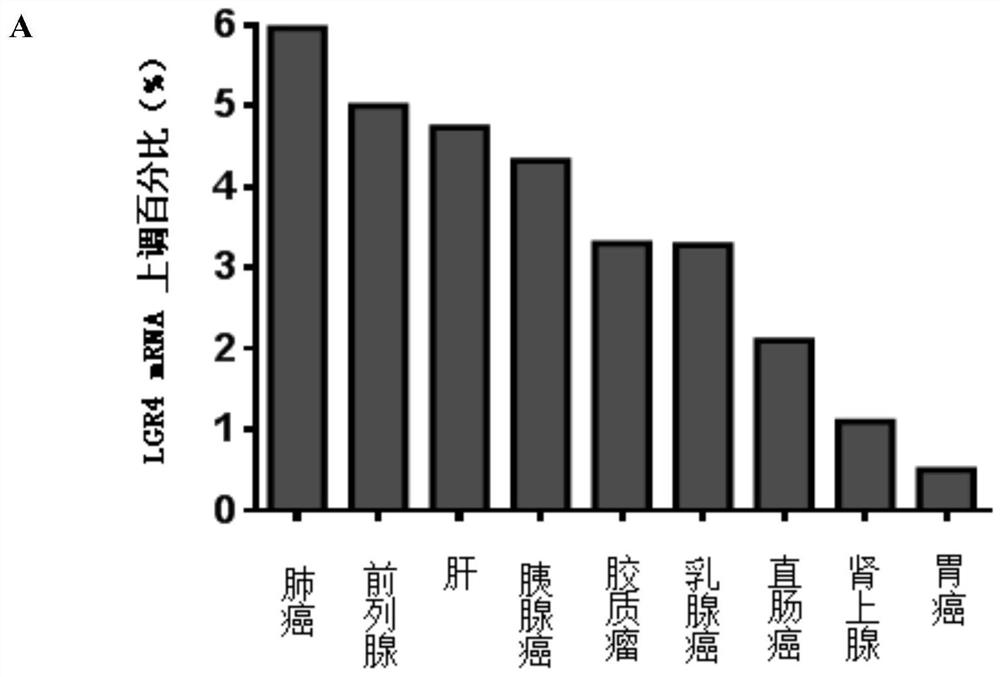lgr4 and r-spondin binding inhibitors and their use in tumor therapy
A technique for inhibitors and uses, which is applied in the field of LGR4 and R-spondin binding inhibitors and its application in tumor therapy, and can solve problems such as limited therapeutic effect and low immunogenicity
- Summary
- Abstract
- Description
- Claims
- Application Information
AI Technical Summary
Problems solved by technology
Method used
Image
Examples
Embodiment 1
[0102] Construction of mouse LLC lung cancer cell subcutaneous xenograft model and detection of Lgr4 expression level in tumor-associated macrophages
[0103] Mouse Lewis lung cancer cell line LLC cells were purchased from the American Type Culture Collection (ATCC) and cultured in dulbecco's modified eagle medium (DMEM) complete medium (10% fetal bovine serum, 100 μg / ml streptomycin) according to its instructions. , 100U / ml penicillin, non-essential amino acids were purchased from GIBCO and diluted according to the instruction manual). Cultivate LLC cells in a 6cm culture dish. When it grows to 80%-90% of the bottom area of the dish, discard the upper medium, wash twice with preheated PBS buffer at 37°C, and add 500μl 0.25% trypsin to the dish. Protease + 0.02% EDTA was digested at 37°C for 30s, then an equal volume of DMEM complete medium was added to stop the digestion, centrifuged, and the cells were resuspended with PBS buffer, and the cell concentration was adjusted to...
Embodiment 2
[0113] Induction and culture of mouse bone marrow derived macrophages (BMM) in vitro
[0114] The method of in vitro induction and culture of BMM is as follows:
[0115] 1. Take 6-8 week old C57BL / 6 mice, kill them by cervical dislocation, and disinfect the body surface with 75% alcohol.
[0116] 2. Cut open the abdomen and peripheral skin to expose the groin, and cut off the two hind limbs of the mouse along the groin, taking care not to cut off the femur.
[0117] 3. Use scissors and tweezers treated with 75% alcohol to peel off the muscles of the hindlimb, and separate the tibia and femur (femur and shank).
[0118] 4. In a sterile environment (such as in an ultra-clean workbench), cut open the two ends of the tibia and femur in sequence to expose the bone marrow cavity. Use a syringe to absorb about 5ml of BMM conditional culture and repeat blowing until the bone marrow cavity turns white. The femur is thin, and it is recommended to use a 1ml syringe for flushing.
[01...
Embodiment 3
[0126] Flow cytometric staining of BMM
[0127] The Lgr4 that embodiment 2 prepares + / + and Lgr4 - / - BMM was cultured in a six-well culture plate, replaced with ordinary DMEM complete medium, and treated cells with 500ng / ml R-spondin1 and 500ng / ml R-spondin3 for 24 hours, digested cells, resuspended, and adjusted the cell density to 1×10 6 / ml, take 200 μl of cell suspension and place it in a flow analysis tube for staining. Under dark conditions, use APC-labeled rat anti-mouse F4 / 80 monoclonal antibody (APC-anti-F4 / 80) and FITC-labeled rat anti-mouse CD206 monoclonal antibody (FITC-anti-CD206) in sequence Incubate at 4°C in the dark for 40 minutes, the amount of antibody used is 0.1 μg / 10 5 cell. After staining, each tube was washed with 1ml of PBS buffer containing 0.2% fetal bovine serum three times (800rpm / min, 3 minutes), and finally the cells were resuspended in 200μl of PBS buffer for flow cytometry analysis. Set the isotype control group, single-staining group and...
PUM
 Login to View More
Login to View More Abstract
Description
Claims
Application Information
 Login to View More
Login to View More - R&D
- Intellectual Property
- Life Sciences
- Materials
- Tech Scout
- Unparalleled Data Quality
- Higher Quality Content
- 60% Fewer Hallucinations
Browse by: Latest US Patents, China's latest patents, Technical Efficacy Thesaurus, Application Domain, Technology Topic, Popular Technical Reports.
© 2025 PatSnap. All rights reserved.Legal|Privacy policy|Modern Slavery Act Transparency Statement|Sitemap|About US| Contact US: help@patsnap.com



